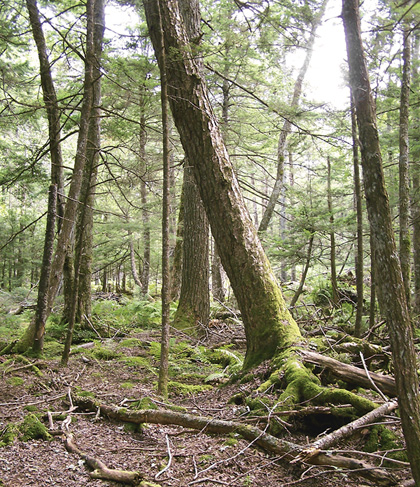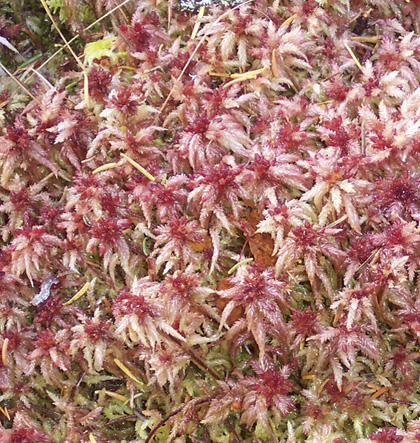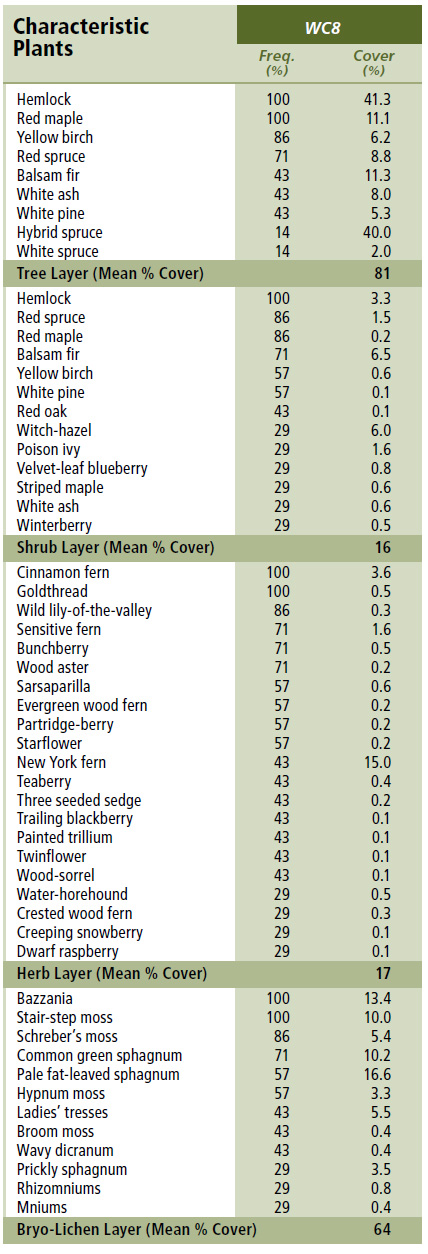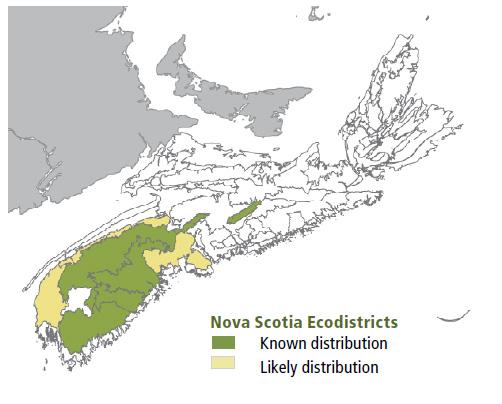
Forest Vegetation types - WC8
WC8 — Hemlock / Cinnamon fern – Sensitive fern / Sphagnum
Tsuga canadensis / Osmunda cinnamomea – Onoclea sensibilis / Sphagnum spp.
 |
South Brookfield, Queens County |
Concept: Poor to very poorly drained mineral soils support the relatively uncommon Hemlock / Cinnamon fern - Sensitive fern / Sphagnum forest. This is the wettest hemlock forest in Nova Scotia. The Vegetation Type (VT) occurs in warmer ecoregions where it persists as an edaphic climax. WC8 is characterized by hemlock canopy dominance and prominent cinnamon fern, sensitive fern and common green sphagnum.
Vegetation: Crown closure is high in the typically evergreen canopy. Most stands are strongly dominated by hemlock, but some are co-dominated by moderate amounts of red maple. Other trees (e.g. red spruce, yellow birch) are frequent but very sparsely scattered. The understory is relatively open, with low woody and herbaceous density but high sphagnum cover. Characteristic species include cinnamon fern, sensitive fern, wood aster, common green sphagnum and common upland plants.
Environmental Setting: Most occurrences are on poorly drained mineral soil derived from glacial till deposits, but organic sites are occasionally occupied. Soils have moderate nutrient availability, largely maintained by the flow of ground water and sometimes surface water. This ecosystem occurs in sites that are more sheltered than most coniferous wetlands of Nova Scotia. It is somewhat restricted to the warmer western ecoregion, but may also be found in the eastern ecoregion. This ecosystem has been observed in parts of southern New Brunswick and on Prince Edward Island but is much more common in Nova Scotia.
Successional Dynamics: This is a mid to late successional ecosystem, typically supporting uneven-aged stands. Most occurrences are maintained by gap dynamics, but some stands show evidence of small-scale timber harvest. Windthrow and harvesting are the main stand-level disturbance agents. The mature forest may succeed from WC6 (Balsam fir / Cinnamon fern – Three seeded sedge / Sphagnum), WD6 (Red maple – Balsam fir / Wood aster / Sphagnum) or WD8 (Red spruce – Red maple / Wood sorrel – Sensitive fern / Sphagnum). Depending on disturbance history and nearby stand composition, WC8 may transition from WC5 (Red spruce – Balsam fir/ Cinnamon fern / Sphagnum).
Ecological Features: A common landscape component in northern New England, this uncommon wet forest is the most temperate coniferous wet forest in Nova Scotia. It occurs in sheltered basins, sometimes near open wetlands, but more often as small to moderate sized patches in upland matrix forest. The dense canopy overtops a sparse woody understory but usually extensive herbaceous and bryophyte cover. In western Nova Scotia, where most stands occur, this ecosystem is a locally important component of landscape structure. It supports unique habitat values including thermal cover for moose, foraging habitat for numerous birds, and shelter for invertebrates, amphibians and reptiles. Few rare plants are documented, but black ash, alder-leafed buckthorn and various Atlantic Coastal Plain species have been observed. Old growth potential is moderate to high.
 |
| Red fat-leaved sphagnum |
Distinguishing Features: Hemlock is diagnostic of this poorly drained mixedwood or softwood forest. Yellow birch, red maple, balsam fir and red spruce are common. The woody shrub layer is primarily regenerating tree species.
| Slope Position: | Level9 Toe1 |
Surface Stoniness: |
(Very - Excessively)4 (Non - Slightly)3 (Moderately)3 |
Bedrock Outcrop: |
(Non-rocky)9 (Slightly - Moderately)1 |
Elevation Range: |
44 - 167m |
Slope Gradient: |
Level10 |
Aspect: |
North1 None9 |
Exposure: |
Mod. sheltered6 Moderate4 |
Microtopography: |
Level8 Slightly1 Moderately1 |
Drainage: |
Poor7 Very poor3 |
Soil Type: |
ST47 ST101 ST131 ST141 |
Parent Material: |
Glacial till7 Organic2 Alluvium1 |
Rooting Depth (cm): |
(<30)10 |
Duff Thickness (cm): |
(6-10)3 (11-20)6 nd1 |

